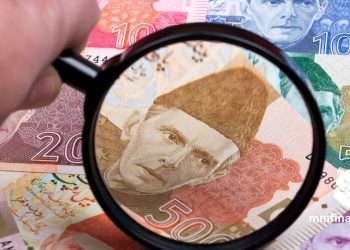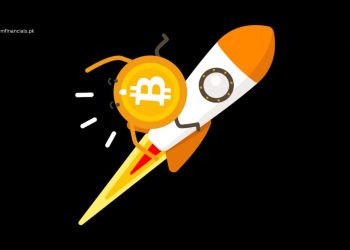The benchmark KSE-100 Index concluded Tuesday’s trading session at 77,877.41 with a decline by 102.88 per cent or 0.13 percent.
The index was traded in the range of 458.65 points with an intraday peak that was 78,275.97 (+295.68) as well as the lowest in the range of 77,817.32 (-162.97) numbers.
The total value for the KSE-100 Index was 183.96 million shares.
Of the 100 index companies, 41 were closed 53 remained closed five remained unchanged and one remained untraded.
The top losers of the day The top losers of the day were BNWM (-7.85 percent), THALL (-3.99%), DGKC (-2.39%), PTC (-2.06%) and FFBL (-2.02%).).
On the other hand top gainers included JVDC (+10.00 percent), PIBTL (+7.63%), YOUW (+5.43%), MARI (+3.95%) and IBFL (+3.20 percent).
As for index-point contribution those companies that brought the index down included HUBC (-59.55pts), FFC (-33.68pts), MTL (-25.56pts), THALL (-19.37pts) as well as EFERT (-16.67pts).
The companies that contributed percentage points included MARI (+109.72pts), LUCK (+21.94pts), JVDC (+16.57pts), POL (+12.38pts) as well as PIBTL (+9.99pts).
In terms of sector, KSE-100 Index was let down by the Fertilizer (-59.61pts), Power Generation & Distribution (-59.48pts), Commercial Banks (-55.92pts), Automobile Assembler (-26.00pts), and Automobile Parts & Accessories (-19.37pts).
The index was also supported with Oil & Gas Exploration Companies (+117.40pts), Property (+16.57pts), Transport (+9.99pts), Pharmaceuticals (+9.36pts), and Insurance (+7.62pts).
In the overall market in the broader market, The All-Share Index closed at 50,023.67 with net losses that was 63.31 percent or 0.13 percent.
The total trading volume of 604.14 million shares as compared to 415.17m in the previous session. The traded value was Rs19.98 billion indicating a decline of Rs2.26bn.
There were 250,854 trades recorded in 442 companies, with 182 closing up while 211 closed down and 49 remaining unaffected.
Symbol Price Change % Volume
Top Ten by Volume
KOSM 8.32 8.90% 131,917,010
YOUW 5.63 5.43% 89,200,219
HASCOL 6.79 4.14% 47,802,550
WTL 1.17 0.00% 28,386,075
AIRLINK 132.37 10.00% 19,302,613
AMTEEF 3.47 10.51% 16,849,320
PIBTL 5.5 7.63% 12,678,889
HUBC 146.38 -1.29% 12,130,223
KEL 4.1 0.74% 8,922,464
SPEL 52.58 5.06% 8,536,866
For reference, the KSE-100 has dropped 568 points, or 0.72 percent during the fiscal year. However, the calendar year that is currently in effect has been witness to a cumulative growth of 15,426 points, which is equivalent to 24.70 percent.
PAKISTANI RUPREE
The Pakistani rupee (PKR) declined in value by 6.06 the paisa, or 0.02 percent in comparison to the US dollar during Tuesday’s interbank session, settling this trade with PKR 278.7 in USD. as compared to the earlier closing at 278.64.
The currency was able to reach the intraday highest (bid) in the range of 279.00 and the lowest (ask) in the range of 278.90.
On the open market, exchange firms listed the dollar at 279.46 to buy and 280.4 to sell.
In comparison to the major currency pairs, PKR lost 20.56 paisa against the Euro and closed at 304.52 as compared to its previous figure of 304.32.
The British Pound soared in value by 1.05 rupees, closing at 356.84 in comparison to 355.78 the previous day.
The Swiss franc gained 47.74 paisa. It closed at 321.51 in comparison to 321.03 in the prior session.
In comparison to against the Japanese currency, the Yen PKR was up 0.83 paisa to close at 1.8846 in comparison to 1.8929 the previous day.
The Chinese Yuan increased 3.96 the paisa and closed the session at 38.86 against 38.82 in the previous session.
The Saudi Riyal ended the day at 74.24 with an increase of 0.24 paisa over its value of 74.23 one day ago.
The U.A.E Dirham increased in value by 1.65 paisa. The value increased from 75.88 the previous day to 75.86.
In the current calendar year PKR is depreciating against the dollar by 36.17 paisa, or 0.13 percent. In contrast, the calendar year has witnessed PKR rise by 3.16 rupees, or 1.13 percent.
Within the Money Market, the benchmark 6-month Karachi Interbank bid and Offer rates dipped by 4bps to 18.5 percent and 18.75 percentage.
GOLD PER TOLA
The price per tola for 24 gold karats on Tuesday saw an increase of 1,200 rupees and was sold at Rs 257,700 on the local market.
The price for 10 grams 24 karat gold also was increased by Rs.1,029 and it was bought at Rs.220,936 while the value of gold with 22 karat was recorded at Rs202,525. All Sindh Sarafa Jewellers Association announced.
The price per tola and ten grams of silver were the same with Rs.2,850 and Rs.2,443.41 and Rs.2,443.41 respectively.
Gold prices on the world market increased by $19, bringing it to $2,458, in comparison to the previous rates of $2,439, according to the Association said in a report.
It is reported that Gold (XAU/USD) trades at $2,470 on Tuesday, following the release less-than-expected US Producer Price Index (PPI) data, which boosts the value of the price of the precious metal after an unsteady beginning. The data suggests a decrease in inflationary conditions, which will likely raise expectations that of the Federal Reserve (Fed) will adopt a more aggressive approach to lower interest rates during their September meeting. The lower interest rate is a plus for Gold because they lower the risk of holding the interest-free asset.
The CME FedWatch tool that evaluates the market-based probabilities for the Fed cutting rates has boosted the chance of an 0.50 percent cut from the Fed in September to 55.5 percent after the publication data from the PPI data. This is in contrast to the 50% likelihood prior to the data was released.
US PPI increased by 0.1 percent in July on a month-overmonth basis, which was in line with expectations, but below the 0.2 percent reported in June. Over the course of the year, however it slowed to 2.2 percent, which was below expectations of 2.3 percent from an upwardly revised 2.7 percent prior to the information provided by the US Bureau of Labor Statistics.
PPI ex energy and food increased by 0.0 percent in July, a decrease of 0.2 percent forecast and the downwardly revised 0.3 percent in June. In a YoY perspective, PPI ex food and energy increased by 2.4 percent and was lower than the forecast of 2.7 percent and 3.0 percent in June.
Gold is rallying due to decreasing US bond yields
Gold has been gaining in response to increased expectation that the Federal Reserve (Fed) will dramatically cut interest rates in September.
The decrease of US bond yields during recent weeks is a reflection of the lower expectations for interest rates that are generally favorable for the price of Gold. Rates of yield as well as Gold price are in negative correlation as illustrated in the chart below which shows Gold price to yield of US 10 year Treasury Bonds.
US Consumer Price Index (CPI) data for July will release on Wednesday and may further sway expectations about future change in interest rates. This could, in turn, affect Gold.
US CPI is anticipated to have increased by 0.2 percent in July, compared to the previous month as well as for headline as well as core. This follows an increase of 0.1 percent decline in headline inflation and the 0.1 percent rise in Core in June. If the actual figure is higher than expectations, suggesting that prices are shaky, it could make it difficult to believe the Fed will reduce interest rates in September, which could hurt the gold price.
Geopolitical Risk
The demand from Central banks for Gold was at its highest in the early stages of Russia’s incursion into Ukraine and highlighted Gold’s role as a safe-haven. The demand for Gold has slowed in the course of time according to Redward Associates, which collaborates with the spread-better IG index to create the Monthly Gold Report.
If Iran launches a massive military strike against Israel but it is possible that similar amounts of demand can be anticipated, causing a rise in the Gold price in turn. Furthermore, Ukraine has raised the stakes in its fight against Russia by occupying Russian territory. This could lead to a resurgence of Gold purchasing from investors. If one of these hotspots becomes more dangerous to the stability of the world Investors are likely to respond by buying Gold to secure their assets.
The position of gold is an obstacle
Despite the many bullish factors pushing up prices of Gold The information from Gold exchanges indicates that the positioning of the Gold derivatives market has reached an overextended stage that could be a sign of vulnerability to a retreat, which could indicate a decrease in demand and a fall in the value of the underlying Gold.
The graph below illustrates the way Gold Futures positioning has moved by a standard deviation from the norm, indicating that long-term positions have been extended. The normal reaction is for the position to mean-revert, which indicates the possibility of a pullback.
There is a huge over-the counter Options market also has an overwhelming favor for bullish options showing optimism, as per reports from Redward Associates and IG Index report. According to the report “option volatility skewed in favor of Gold call options at all tenors out to twelve months, with one-month option, volatility skewed 2.1% in favor of calls,” the report states.
“While we see good reason for this optimism – notably ongoing solid Central Bank demand for Gold, coupled with the expectation of easier US monetary conditions leading to a weaker US Dollar and lower US real long-term Bond yields – positioning and technical indicators pointed to position extension,” the report claims.
Technical Analysis: Gold is at the highs and is able to pull back
Gold has surged to the highest point of a range that it has been fluctuating since July. After reaching the ceiling on Monday, it has retreated. It is likely to be trending sideways and, if “the trend is your friend” it is likely to continue in this direction.
XAU/USD 4-hour Chart
The pair has been rolled over after a record high of $2,477 earlier and is poised to begin an upswing in the same range expanding the sideways trend. An Engulfing bearish Japanese candlestick has been formed near the high end of the range. in the event that the current 4-hour period is concluded with a bearish red candle it will give additional confirmation of a possible reversal lower in the short term. If it is true the price is confirmed, it could fall to $2,400 at at the very least, or maybe even to it will hit the floor at $2,390. Given that it is narrowing this could also be a triangle in the last stage of its development.
A clear break over the limit of the range however, is necessary to show that an upward trend emerging. A move like this could be at or near $2,550. The figure is estimated by taking around an 0.618 Fibonacci ratio of the range’s height and extending it up.
A definitive break is one marked by a lengthy green candle that clearly pierced through the level before closing at its highest point or three green candles in one row, which pierced the limit.















